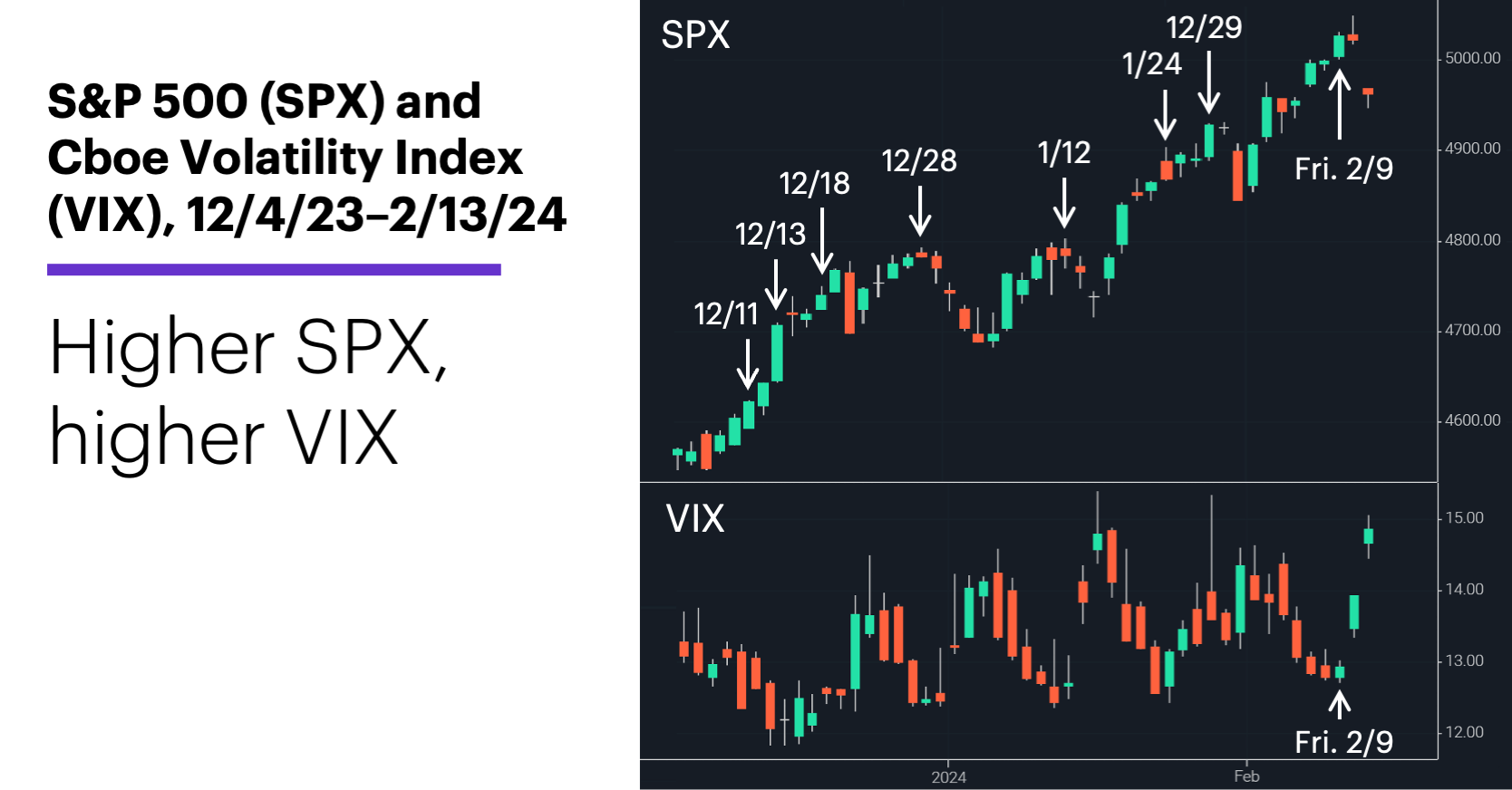A heads-up from the VIX
- VIX closed higher last Friday despite S&P 500 record
- Pattern implied potential volatility uptick
- Pullbacks more common than reversals?
Tuesday’s stock market sell-off may have appeared to be simply a matter of unexpectedly hot inflation data from the consumer price index (CPI), but even before that news crossed the wire, one indicator may have given traders notice that a stumble was at least possible.
Last Friday, the Cboe Volatility Index (VIX) closed higher as the S&P 500 (SPX) pushed to another record high and its first-ever close above 5,000. After hitting a new intraday high, the SPX closed slightly lower on Monday, then turned that pause into a full-blown pullback on Tuesday.
Days when the SPX and VIX both close higher aren’t exceptional—there have been more than 940 since 1990. It’s when these events occur that arguably matters. Over time, the VIX and the SPX tend to move in the opposite direction, so when the VIX pushes higher when the SPX is making a medium- to longer-term high, traders tend to take notice. A higher VIX on a day the SPX pushes to a longer-term high implies the options market is expecting increased volatility—i.e., a possible market downturn—when it arguably “should” be feeling good about the market’s prospects.
For example, the VIX closed higher when the SPX hit its highest high in at least 60 trading days 215 other times since 19901—roughly once every two months, on average. The pattern has unfolded more frequently over the past couple of months, including last Friday:

Source: Power E*TRADE (For illustration purposes. Not a recommendation. Note: It is not possible to invest directly in an index.)
While this signal has occasionally occurred near significant market highs (e.g., on February 2, 2023 and August 15, 2022), these examples are fairly representative of what happened after the majority of them—a short-term pullback or a pause. In some cases, the SPX pulled back over the next few days, in others it barely missed a beat or immediately pushed higher. In five out of the eight examples, though, the SPX lost ground for at least a day or two before turning higher.
Overall, the SPX had negative average returns for the first two days after the 215 previous examples, positive average returns for the next two days, and was slightly more likely (107 times vs. 106 times) to be lower after five days.
The market’s “response” to Friday’s signal is still in progress. The stock market doesn’t fall just because the VIX climbs when the stock market rallies. It’s simply a heads-up that the options market is more concerned about increased volatility. Sometimes the options market will be right, sometimes it will be wrong. Unique factors at work in the market at a given time will determine whether or not the options market’s concern was misplaced. But either way, it doesn’t hurt to be put on notice.
Market Mover Update: Following up on last week’s call options surge (see “Tech stock gets jump on earnings”), JFrog (FROG) traded more than 38 times its average call volume (and 12 times its average put volume) on Monday, while its stock swung from being up more than 3% on the day to closing nearly 5% lower. On Tuesday, FROG appeared again on the LiveAction scan for unusual call volume, as shares fell 7.6% intraday before trimming their losses. The company is scheduled to release earnings after today’s close.
Consumer spending has been a big part of the economy’s surprising performance over the past year, and in “Three Reasons the U.S. Consumer Outlook Remains Strong,” Morgan Stanley & Co. analysts explain the factors that could keep it going this year.
Today’s numbers include (all times ET): mortgage applications (7 a.m.), EIA Petroleum Status Report (10:30 a.m.).
Today’s earnings include: Avantor (AVTR), CME Group (CME), Global Payments (GPN), Kraft Heinz (KHC), Martin Marietta (MLM), Tower Semiconductor (TSEM), AppLovin (APP), Cisco (CSCO), Occidental Petroleum (OXY).
Click here to log on to your account or learn more about E*TRADE's trading platforms, or follow the Company on Twitter, @ETRADE, for useful trading and investing insights.
1 All figures reflect S&P 500 (SPX) and Cboe Volatility Index (VIX) daily prices, 1990–2024. The specific pattern referenced consists of a day on which the SPX makes its highest intraday and closing high in at least 60 trading days, and the VIX also closes higher after closing lower the previous day. Supporting document available upon request.